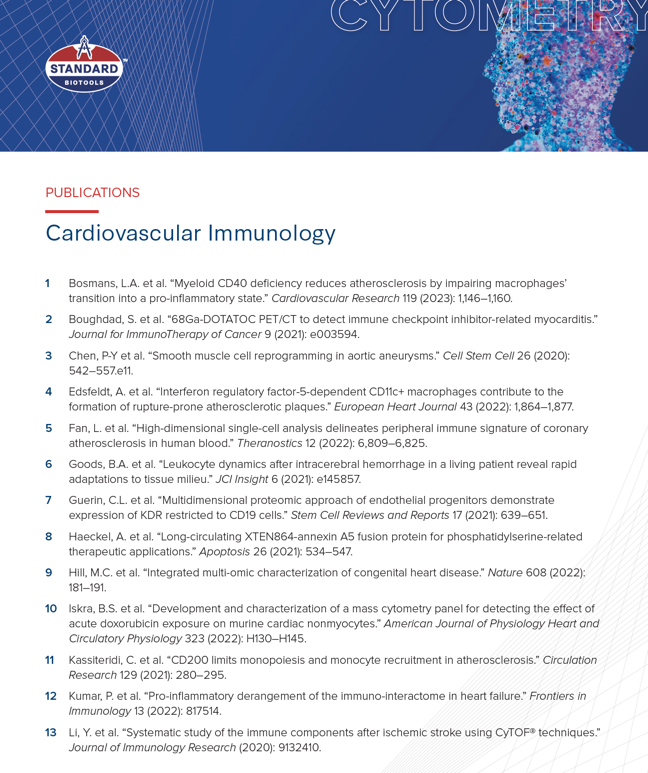Biomarker Discovery
Discovering new biomarkers using
Imaging Mass Cytometry
Biomarkers are currently used in research and in clinical practice, yet few are used to predict a clinical therapeutic outcome consistently and accurately. This is particularly true for cancer and other diseases with high tumor heterogeneity and broad cellular signatures, where classification at an individual level may be confounding. Imaging Mass Cytometry™ (IMC)™ technology can uncover novel phenotypes and identify therapeutic targets that may be relevant to developing biomarkers and future treatment strategies.

Featured Application
Cardiovascular immunology
With over 2,000 publications and 200 clinical trials, CyTOF™ flow cytometry and tissue imaging can be used for a variety of immune and non-immune related diseases. Here we narrow in on an emerging area for high-parameter cytometry.
Truly understanding cardiovascular disease, a leading cause of death globally, requires single-cell technology that enables unprecedented exploration of a complex cellular landscape.
Background can be a challenging issue when imaging cardiac tissue. Imaging Mass Cytometry technology, the only proven high-plex imaging with no autofluorescence, helps deliver clear insights that can provide a comprehensive view of molecular pathogenesis, signaling mechanisms and immune-mediated damage in the heart or related cardiac tissues.
Read about how high-plex imaging uncovers spatial biology insights in cardiology disease
Potential indicative immunotherapy biomarker in melanoma
Martinez-Morilla and colleagues demonstrated the use of IMC systems to quantitatively measure 25 markers to simultaneously generate data from tumor, stroma, T cells, B cells and macrophages. Using IMC technology with biopsy samples from metastatic melanoma patients who received immunotherapy, the team discovered a compelling biomarker potentially indicative of treatment response in melanoma.
Answering key questions about the role of CAFs in lung cancer
In her webinar, Handan Xiang, PhD, describes how she and the team at Merck use IMC studies to understand cancer-associated fibroblasts (CAFs) in tumor stroma. Learn how this research illuminated a possible therapeutic path that could potentially reverse a CAF-mediated immunosuppressive microenvironment.
Novel signaling networks identified through IMC and transcriptomics data integration
The use of IMC technology enabled researchers to uncover the heterogeneity of cellular phenotypes and cell-to-cell interactions in the tumor microenvironment of high-grade serous ovarian cancer to understand which interactions might influence patient survival. Learn about the pipeline used to generate PhenoGraph clusters for cell density and neighborhood analysis along with correlating the IMC phenotype with a gene expression profile.
Unique expression signatures in Hodgkin lymphoma aid in the development of novel biomarkers
Scientists aim to unravel the very complex tumor microenvironment (TME) of Hodgkin lymphoma by deciphering the unique immune cell architecture of the TME and for the first time unveil its phenotype. They pair IMC systems with single-cell transcriptome analysis and suggest implications for the development of novel therapies, including rational combinations and predictive biomarker development.
Customer Stories
Learn more about how our customers are leveraging Standard BioTools technology.
Yongpan Yan, PhD

An approach that combines molecular biology, immunology and cell biology tools to uniquely
Febe van Maldegem, PhD, and Karishma Valand

Imaging the dramatic remodeling of the lung tumor microenvironment
Melissa Davis, PhD

Defining spatial characteristics using Imaging Mass Cytometry™ technology
For Research Use Only. Not for use in diagnostic procedures. Patent and License Information: www.standardbio.com/legal/notices. Trademarks: www.standardbio.com/legal/trademarks. Any other trademarks are the sole property of their respective owners. ©2025 Standard BioTools Inc. All rights reserved.

